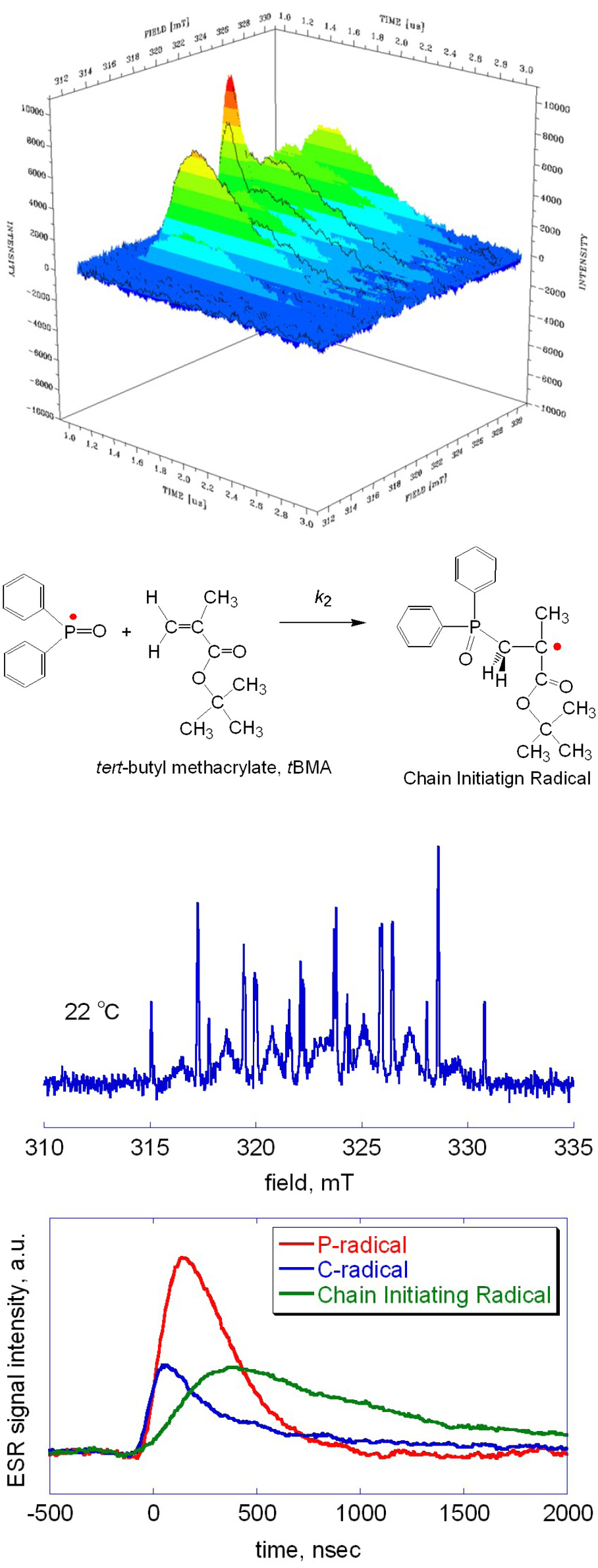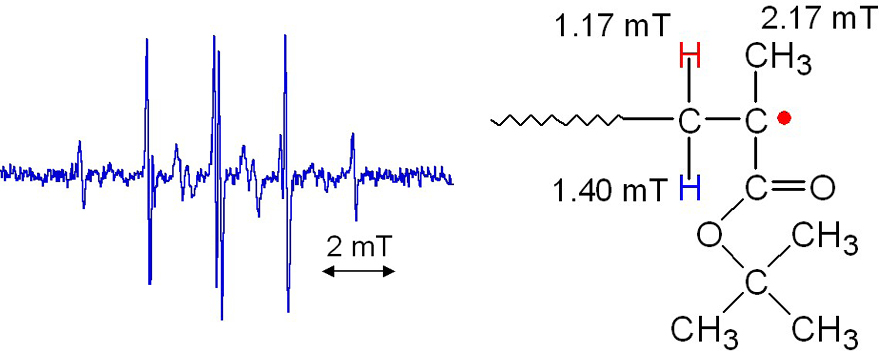Critically Evaluated ESR (EPR) Spectra of Important Polymerization-related Radicals
Electron spin resonance (ESR) spectroscopy, also referred to as EPR (electron paramagnetic resonance), allows for the direct observation of radicals, thus being of eminent importance for detailed investigations into radical polymerization. ESR spectra provide information on the structures, properties, and concentrations of the radicals. ESR detection of radicals has been difficult under stationary polymerization conditions at low radical concentration. The quality of ESR spectrometers has, however, been largely improved. Moreover, with the advent of pulsed lasers, large radical concentrations may be instantaneously generated and subsequently monitored at high time resolution.
Steady-state ESR (SS ESR) measurements have been a major technique for the direct detection of radicals during radical polymerizations. In this project two more techniques of ESR in combination with pulsed laser are employed. One is time-resolved (CIDEP) ESR (TR ESR) and the other is single pulse-pulsed laser polymerization-EPR (SP-PLP-EPR). These techniques have different time resolution. The time regions are from nsec (10-8-10-7 sec) to μsec (10-6-10-5 sec) for TR ESR and from μsec to msec (10-5-10-4 sec) for SP-PLP-EPR. The time resolution of SS ESR is longer than msec. Initial radical addition reactions can be observed by TR ESR and the initial stage to first several steps of radical addition reactions can be detected by the SP-PLP-EPR technique. SS ESR can provide information on propagating radicals with long propagated chain. Various aspects of radical polymerization reactions can be observed by these three techniques. The resulting ESR spectra can provide rate coefficients of each elementary process and the activation energy (Ea) of the reactions based on temperature dependent measurements. Figure 1 shows a typical 3D image of the TR ESR spectrum of radical polymerizations of tert-butyl methacrylate (a) with a scheme of observed radical addition reaction (b) as an example. Slice at constant time provides a spectrum with hyperfine splitting (Fig. 1(c)) and detailed structure can be determined from the spectrum. Time profiles of the each spectroscopic line (Fig. 1(d)) are strongly correlated with reaction kinetics. When the same polymerization was observed by SS ESR, the ESR spectrum of propagating radicals can be detected, as shown in Figure 2. Initiation and propagating processes of the same polymerization system were observed by TR and SS ESR spectroscopies.

A typical 3D image of the TR ESR spectrum of radical polymerizations of tert-butyl methacrylate.

SS ESR spectrum of propagating radicals
Moreover, single pulse experiments provide access to chain-length-dependent termination, to transfer, and even to propagation rate coefficients. The method is also applicable to reversible addition fragmentation transfer (RAFT) and atom-transfer radical polymerization (ATRP) kinetics. The multitude of powerful ESR techniques enables the quantitative detection of specific radicals over the entire course of a polymerization reaction. Application of these methods requires the accurate knowledge of the ESR spectra and associated hyperfine coupling constants (hfcs). Since values of hyperfine splitting constants were determined very precisely from the spectrum, it was reasonably well simulated as the corresponding propagating radical. Absolute values of the hyperfine splitting constants are proportional to the spin densities of each element and the spin density is strongly correlated with electron density. The precisely determined hfcs data will provide significant information on theoretical calculations of properties of radicals. No hfcs on polymerization-related radicals have been tabulated since Rånby and Rabek´s book on ESR Spectroscopy in Polymer Research (Springer, 1977).
A critically evaluated update of the available data and of recommended experimental methods is urgently required, in particular as novel monomers and polymerization techniques have been introduced. Experimentalists, methodologists, and theoreticians will cooperate within the project to establish a database of reliable ESR spectra for use in academia and industry.
For more information, contact the Task Group Chair Atsushi Kajiwara <kajiwara@nara-edu.ac.jp>
©2016 by Walter de Gruyter Berlin/Boston
Articles in the same Issue
- Masthead - Full issue pdf
- Guest Editorial
- Outer Limits: Pushing the Extremities
- Contents
- Officer’s Column
- Secretary General’s Column
- Features
- The Three-letter Element Symbols:
- Procedures for the Naming of a New Element
- The Chemical Structure Association Trust
- IUPAC Wire
- Discovery and Assignment of Elements with Atomic Numbers 113, 115, 117 and 118
- Open Data in a Big Data World
- UN Secretary General Appoints ICSU Executive Director to Special Advisory Group on the SDGs
- Project Place
- Company Associates Reengineering Project
- Postgraduate Course in Polymer Science, Prague, Czech Republic
- Critically Evaluated ESR (EPR) Spectra of Important Polymerization-related Radicals
- Which Elements Belong in Group 3 of the Periodic Table?
- Making an imPACt
- Discovery of the elements with atomic numbers Z = 113, 115 and 117 (IUPAC Technical Report)
- Discovery of the element with atomic number Z = 118 completing the 7th row of the periodic table (IUPAC Technical Report)
- Glossary of terms used in computational drug design, part II (IUPAC Recommendations)
- Standard electrode potentials involving radicals in aqueous solution: inorganic radicals (IUPAC Technical Report)
- Maritime pollutants in shipping and commercial European ports based on relevant physical and biogeochemical environmental parameters (IUPAC Technical Report)
- Latest Updates from PAC Conferences & More—Brief
- IUPAC Provisional Recommendations
- Glossary of Terms Used in Developmental and Reproductive Toxicology
- How to Name Atoms in Phosphates, Polyphosphates, their Analogues, and Transition State Analogues for Enzyme-catalysed Phosphoryl Transfer Reactions
- Comprehensive Definition of Oxidation State
- Stamps International
- Berzelius and the Chemical Alphabet
- Conference Call
- Latin American Pesticide Residue Workshop—Food and Environment
- Ecological Risk Assessment
- Where 2B & Y
- New Chemistries for Phytomedicines and Crop Protection Chemicals
- Function Through Disorder: Intrinsically Disordered Proteins in Biology and Medicine
- Phosphorus Chemistry
- Self-assembly in the World of Polymers
- Solubility Phenomena
- Blood-Biomaterial Interactions
- CODATA-RDA School of Research Data Science
- 28th National [Turkish] Chemistry Congress with International Participation
- The Power of Norms
- Selenium Research (Se2017)
- Mark Your Calendar
Articles in the same Issue
- Masthead - Full issue pdf
- Guest Editorial
- Outer Limits: Pushing the Extremities
- Contents
- Officer’s Column
- Secretary General’s Column
- Features
- The Three-letter Element Symbols:
- Procedures for the Naming of a New Element
- The Chemical Structure Association Trust
- IUPAC Wire
- Discovery and Assignment of Elements with Atomic Numbers 113, 115, 117 and 118
- Open Data in a Big Data World
- UN Secretary General Appoints ICSU Executive Director to Special Advisory Group on the SDGs
- Project Place
- Company Associates Reengineering Project
- Postgraduate Course in Polymer Science, Prague, Czech Republic
- Critically Evaluated ESR (EPR) Spectra of Important Polymerization-related Radicals
- Which Elements Belong in Group 3 of the Periodic Table?
- Making an imPACt
- Discovery of the elements with atomic numbers Z = 113, 115 and 117 (IUPAC Technical Report)
- Discovery of the element with atomic number Z = 118 completing the 7th row of the periodic table (IUPAC Technical Report)
- Glossary of terms used in computational drug design, part II (IUPAC Recommendations)
- Standard electrode potentials involving radicals in aqueous solution: inorganic radicals (IUPAC Technical Report)
- Maritime pollutants in shipping and commercial European ports based on relevant physical and biogeochemical environmental parameters (IUPAC Technical Report)
- Latest Updates from PAC Conferences & More—Brief
- IUPAC Provisional Recommendations
- Glossary of Terms Used in Developmental and Reproductive Toxicology
- How to Name Atoms in Phosphates, Polyphosphates, their Analogues, and Transition State Analogues for Enzyme-catalysed Phosphoryl Transfer Reactions
- Comprehensive Definition of Oxidation State
- Stamps International
- Berzelius and the Chemical Alphabet
- Conference Call
- Latin American Pesticide Residue Workshop—Food and Environment
- Ecological Risk Assessment
- Where 2B & Y
- New Chemistries for Phytomedicines and Crop Protection Chemicals
- Function Through Disorder: Intrinsically Disordered Proteins in Biology and Medicine
- Phosphorus Chemistry
- Self-assembly in the World of Polymers
- Solubility Phenomena
- Blood-Biomaterial Interactions
- CODATA-RDA School of Research Data Science
- 28th National [Turkish] Chemistry Congress with International Participation
- The Power of Norms
- Selenium Research (Se2017)
- Mark Your Calendar

